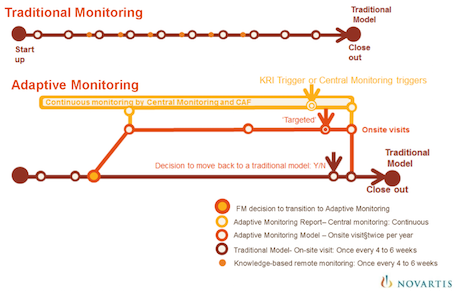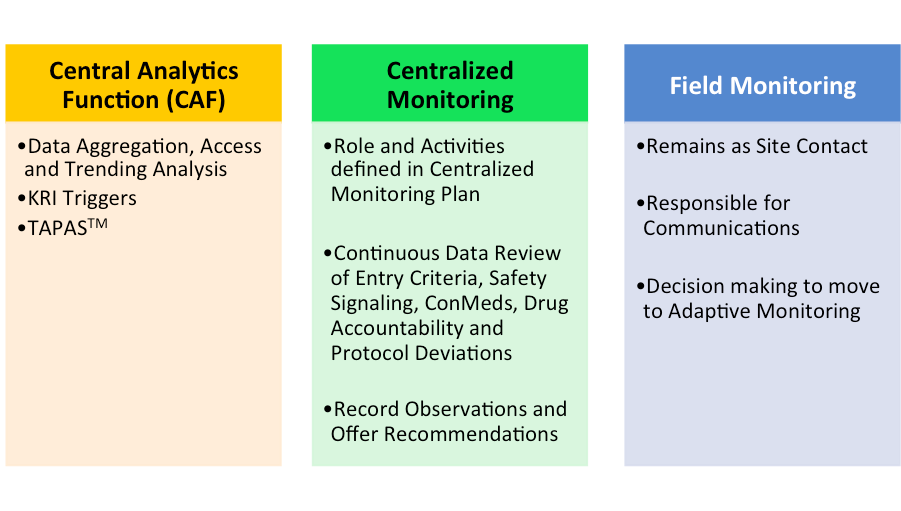Novartis’ Adaptive Monitoring RBM Model
The world of RBM is continually changing as biopharmaceutical enterprises are dabbling into different approaches and methods. There are several outsourced models that exist, when approaching RBM, such as integrating cloud-based solutions to provide centralized monitoring teams with analytics, or fully outsourcing RBM functions and technologies to CROs. However, some companies, such as Novartis, appear to be in-sourcing their RBM technologies and functions.
The world of RBM is continually changing as biopharmaceutical enterprises are dabbling into different approaches and methods. There are several outsourced models that exist, when approaching RBM, such as integrating cloud-based solutions to provide centralized monitoring teams with analytics, or fully outsourcing RBM functions and technologies to CROs. However, some companies, such as Novartis, appear to be in-sourcing their RBM technologies and functions.
Roland Rich, Quality & Compliance Excellence Operations Expert, DevQA at Novartis, recently elaborated on Novartis’ approach towards the centralized and risk-based monitoring function at CHI’s Clinical Trial Oversight Summit. Novartis’ RBM System is activated by a well-designed RBM process, and an in-house technology system, namely Trends and Pattern Alert System (TAPASTM).
Novartis’ Approach on Adaptive Monitoring
Any well designed technology enabled system requires solid and efficient business processes, and Novartis has invested in a simple and adaptable methodology on executing RBM. Novartis’ RBM process is multifaceted; they initially focus their on-site monitoring activities during the site initiation phase, and evaluate study site quality specifications (i.e., does the site need training, are they prone to making protocol deviations, misconduct and noncompliance, etc.) (Figure 1).
Once the field monitor (FM) familiarizes themselves with the study site’s quality, they make a recommendation to the Central monitoring team as to whether the site can proceed to continuous centralized monitoring or not. If the site does not meet quality expectations, the FM will continue monitoring the site traditionally.
Figure 1: Novartis’ Adaptive Monitoring Process

If a site is rolled over to the Adaptive Monitoring category, Novartis monitors the site via its centralized analytics function team (CAF) using mostly TAPAS©, and its centralized monitoring team. This team monitors the data in nearly real time to uncover inconsistencies, deviations, and data errors. Moreover, the team conducts performance assessments to unveil poor performance, potential noncompliance, and misconduct. If key risk indicator (KRIs) thresholds are met, the centralized monitoring team triggers a FM to conduct a targeted monitoring visit.
Novartis’ RBM Functions in Adaptive Monitoring
In order to efficiently execute RBM, Novartis has organized its monitoring activities into three functions, as illustrated in Figure 2.
Figure 2: Novartis RBM Functions

Figure 2 delineates that the centralized monitoring function utilizes the CAF team to access and analyze data quality and site performance data in aggregate, and coordinates with the FM team to qualitatively evaluate site performance and address data discrepancies. This continuous model with separate roles and functions enables Novartis to efficiently oversee clinical trial data quality and monitor site performance.
Centralized VS Field Monitoring: Differences in Roles and Responsibilities
An RBM system is inoperable without specific roles and responsibilities. Novartis has designated specific roles for data analysis and monitoring activities for each function. Naturally the CAF team, mostly supported by TAPAS©, explores through operational data coming from clinical trials looking for risk signals that enables data aggregation for centralized monitoring. Centralized monitors’ roles are defined in a centralized monitoring plan. They are continuously monitoring clinical trial data to ensure it is completed and correct as well as they leverage the CAF team to evaluate data consistency and quality, including inclusion/exclusion criteria, AE/SAE signaling, vital sign abnormalities, Concomitant Medication management, drug accountability and protocol deviations. FMs are responsible for conducting qualitative data assessments including evaluating source document accuracy and completeness, protocol compliance, investigator oversight and drug accountability; ultimately, FMs spend more time building relationships with sites.
TAPAS©: Food for Thought on the Outsourcing Model?
As mentioned earlier, Novartis’ CAF team (powered by TAPAS©) enables the centralized monitoring team to access clinical trial analytics, and analyze site data in aggregate. What is particularly interesting about this model is that TAPAS© is a fully in-sourced system that appears to be compatible with in-sourced clinical trial models, where centralized monitoring and FM functions are employed directly by the sponsor.
So, how can enterprises utilize in-sourced systems, such as TAPAS©, in an outsourcing model? In this case, it’s a matter of which functions the sponsor chooses to outsource. FDA’s RBM guidance indicates that sponsors should ensure that trials are adequately monitored, and that the sponsor should determine the nature and extent of monitoring with a basis on study objectives, complexity, purpose, blinding, design, endpoints and size. Correspondingly, outsourcing the FM function to a CRO while maintaining centralized monitoring in-house would mitigate oversight risks. Alternatively, sponsors may enable in-house centralized monitoring team functions and models, while allowing CROs to simultaneously activate their RBM technologies, centralized monitoring and onsite monitoring infrastructures. However, this model can pose conflicts in terms of RBM process consistency, and whether outsourcing centralized monitoring is financially feasible.
What Can Smaller Biopharmaceutical Enterprises Learn from Novartis’ RBM Model?
Developing a system like TAPASTM is a massive financial and strategic undertaking, and would not make sense for smaller biopharmaceutical enterprises that run fewer clinical trials (and would not benefit from scalability) to approach RBM like Novartis did. Nevertheless, smaller biopharmaceutical enterprises can benefit from mimicking Novartis’ RBM functions (Figure 2), while outsourcing their technology systems to a cloud-based RBM solutions provider.
How Digital Technology and Remote Assessment Strategies Can Aid Clinical Trial Research
July 24th 2020While there's been hopeful news on treatments and vaccines, sponsors should plan to discuss necessary strategies and contingencies at the outset of new studies or re-opening of halted studies during the COVID-19 pandemic.